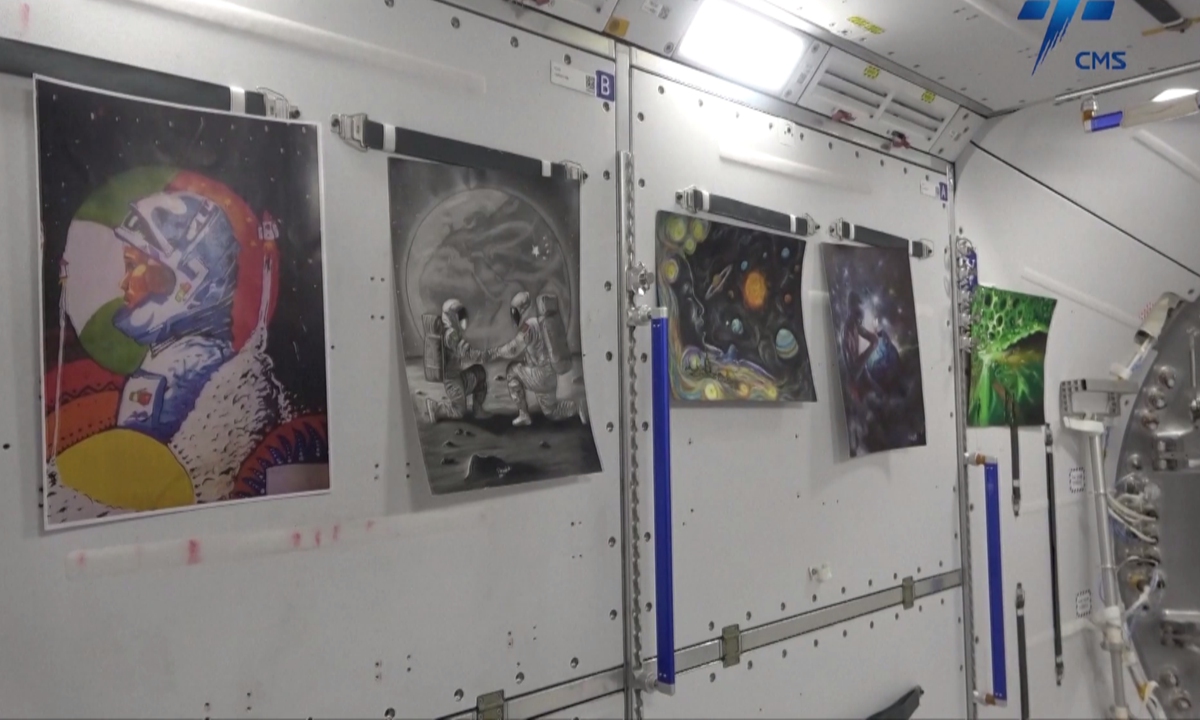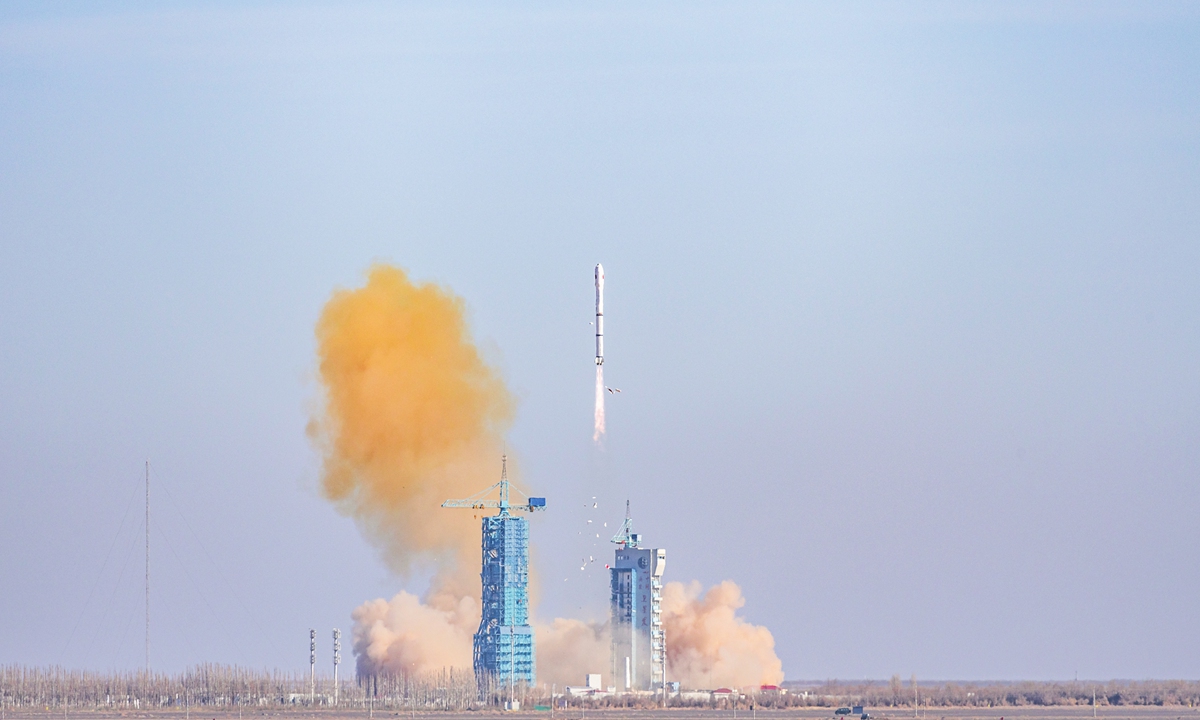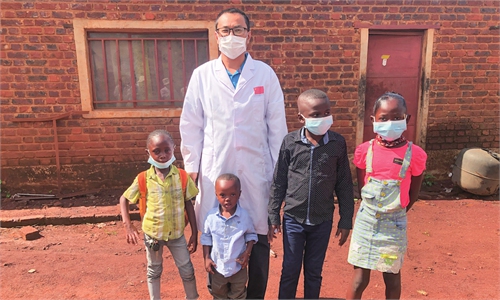IN-DEPTH / IN-DEPTH
China-Africa Rhapsody: China’s space endeavors ignite aerospace dreams among African youth
Galactic bond

Young Africans' paintings are exhibited at China's Tiangong space station, on September 13, 2023. Photo: China Manned Space Agency
Editor's Note:Friendly exchanges between China and Africa have enjoyed a long history and have deepened in recent years, covering various fields such as politics, the economy, and culture. The Global Times is launching a China-Africa Rhapsody series, aiming to showcase the profound human connections and development visions between the two peoples by sharing the true stories of Chinese people in Africa and African people in China. From touching stories of China-Africa cooperation to exciting collisions of youthful ideas, to debunking fallacies concocted by some Western sources about the China-Africa collaboration, this series hopes to promote closer cooperation and deeper understanding between the peoples of China and Africa.
In this installment, we look skyward, focusing on the inspiring narrative of China's remarkable advancements in aerospace technology and how they are not only propelling its own ambitions in vast universe, but also are igniting the dreams of young Africans in aviation and space exploration. As China strides forward in its aerospace endeavors, it simultaneously extends a collaborative hand to Africa's youth, fostering an environment in which their aspirations in aviation can take flight. This synergy of growth and cooperation highlights a mutual journey toward technological mastery and shared dreams, bridging the gap between continents and cultures through the universal language of sky aspirations.

A Long March-2C carrier rocket helps Egypt send a remote-sensing satellite into orbit from the Jiuquan Satellite Launch Center in Jiuquan, Gansu Province, on December 4, 2023. Photo: VCG
Peter Prosper Oshoname from Nigeria has one wish: To see more African astronauts journey into space.
Oshoname expressed his wish through his painting, depicting an image of an African astronaut with a circular emblem of half the Nigerian and Chinese flags on top of her head. The background demonstrates the vastness of the universe with resplendent African motifs and Chinese symbols.
In May 2023, the art piece was sent into China's space station via the Shenzhou-16 manned spacecraft, along with nine other artworks embodying the beautiful dreams of young Africans.
"The circle has no edges, continuously and endlessly rotating. I painted the flags of both countries within a circle to represent harmony and friendship. The different patterns and textures of the circles aim to represent the dreams, diversity, and creativity of African youth," Oshoname explained.
He said that the artwork only includes one character to symbolize the unity of Africa and China, and the joint efforts by both peoples to plant the seeds of space dreams in every child's heart.
Oshoname's painting making its debut at China's space station is a microcosm of space cooperation between China and Africa.
In recent years, with the promotion of mechanisms such as cooperation under the Belt and Road Initiative (BRI) and the Forum on China-Africa Cooperation, much practical progress has been made in aerospace cooperation between the two sides, making greater contributions to the construction of a high-level China-Africa community of shared future and the building of a better world.
Fruitful cooperation has been achieved in satellite exports, satellite resource sharing, space technology exchange, and the construction of space infrastructure. What's more, Chinese space technology has played an important role in the economic and social development of African countries and the improvement of people's living standards in the continent.
During an exclusive interview with the Global Times, South African Ambassador to China Siyabonga Cyprian Cwele said that space cooperation with China "is part of what our leaders said about taking our relations to new heights," and it can enable human beings to monitor but also understand what has happened on other planets.
Growing dreams
In September 2023, 10 paintings created by African youths made their debut at the very first art exhibition on China's space station. They were selected in a competition that received more than 2,000 paintings from 42 African countries, the Global Times learned at the competition's awards ceremony.
Director-General Wu Peng of the Department of African Affairs at the Chinese Foreign Ministry, at the event, said that the art exhibition is a vivid example of China's long-standing commitment to sharing development achievements and opportunities with Africa.
"In today's complex world with intertwined challenges and accelerated changes, the collective rise of developing countries is unstoppable," Wu said. "The youth represent the future and hopes of nations, as well as the driving force behind China-African cooperation. Your aspirations for a better life and your pursuit of the development of China-Africa relations are a continuous source of strength for the inheritance of the traditional friendship between the two sides."
At the event, the Shenzhou-16 crew also extended their greetings to African friends much to the delight of those in attendance. Behind them hung the paintings inside the space station cabin, as they gave detailed introductions of each painting, including the artist, their country of origin, as well as the meaning of the artwork, and the beautiful aspirations it carries.
Gui Haichao, the first civilian taikonaut to ever journey to space, could not help but smile cheerfully the entire time as he immersed himself in the joy that the colorful paintings brought him. Next to him was Shenzhou-16 commander Jing Haipeng, who gave two thumbs-up to the brilliant ideas of African youths, and took out his own photo at one point to share his thoughts and understanding of the paintings, the Global Times saw at the event.
Taking the launch of these youth's symbolic dreams into space as a starting point, the potential for China-Africa space cooperation will be "as broad as the starry sea," said Jing as he showcased the paintings some 400 kilometers above Earth.
"Join us in exploring the vastness of space and unraveling its mysteries to build our shared home," declared Liu Yang, China's first female astronaut, with heartfelt emotion to local students at the Chinese aerospace tracking station in Swakopmund, Namibia. On August 19, 2019, Liu, along with fellow astronaut Chen Dong, embarked on a five-day visit to Namibia, initiated by an invitation from Namibian President Hage Geingob.
This visit, highlighted by the Chinese astronauts' delegation, marks their second journey to Namibia, demonstrating the profound friendship and the high regard in which China holds relations and cooperation with Namibia. Liu and Dong's current visit further cements this special bond.
During their visit, Liu shared insights into an astronaut's training, work, and life, hoping to inspire Namibian youth about space exploration. Chen conveyed the delegation's goal to introduce the developments in China's aerospace industry and plant the seeds of dreams in the hearts of Namibians and, by extension, African youths, with hopes of seeing them in space in the future.
The Namibian students were thrilled. Among them, a 12th grader found inspiration in Liu and said: "Liu is a source of pride for women. With effort, we can also achieve our dreams," according to a Xinhua report.
Cultivating talent
In addition to sowing the seeds of aerospace dreams among the youth, China is actively collaborating with Africa to cultivate talents in related fields.
China places high importance on providing high-quality training for African scientific researchers, especially in areas such as satellite design, manufacturing, launching, and control. Since 2014, China has funded graduate students from countries like Algeria, Egypt, and Ethiopia, providing intellectual support for the autonomous development of aerospace technology in Africa.
Michael Appolinary Malima from Tanzania exemplifies China's role in nurturing African talent in the aerospace field. Having graduated in 2022 from Shenyang Aerospace University in Northeast China's Liaoning Province with a Bachelor's degree in Aeronautical Engineering, Malima, 25, returned to Tanzania for an internship at an airline, ensuring the maintenance and airworthiness of the fleet.
Malima's educational journey offers insights for African students aspiring to study in China. Before arriving in China, he completed 13 years of mandatory education, including two years in science, a prerequisite for studying aerospace engineering.
Despite facing challenges, Malima found his experiences in China refreshing and enlightening. His course was taught in English, but foreign students could also choose Chinese language classes.
Malima's experience shows it is achievable. He graduated with first-class honor, a significant accomplishment given the global conditions during his final study years.
"Provided all things go well, I plan to pursue further studies in aerospace engineering and place my focus on aerospace materials as these tend to lead to the discovery of other materials for various applications both within and outside the earth's atmosphere," he told the Global Times.
He stressed that the cooperation brings awareness to Africans on the opportunities available in the aerospace industry while creating a larger market for aerospace products and growth for both sides.
Building future
Beyond fostering young dreams, China-African aerospace collaboration is significantly boosting African nations' modernization through climate monitoring, disaster prevention, communication technology, and more. These tools effectively tackle extreme weather, food shortages, and environmental fragility.
In December 2023, China helped Egypt send a remote-sensing satellite, the MISRSAT-2, into orbit from the Jiuquan Satellite Launch Center in Northwest China's Gobi Desert, which will be used in Egypt's land and resource utilization, water conservancy, agriculture, and other fields.
The satellite is a landmark project of in-depth cooperation between China and Egypt in the field of high-tech aerospace engineering and is of profound significance in aerospace cooperation between the two countries, according to the China National Space Administration (CNSA).
In developing the satellite, China helped Egypt develop and build a satellite assembly integration testing center, and the successful implementation of the MISRSAT-2 project made Egypt the first country in Africa to have complete satellite development and final assembly and testing capabilities.
Moreover, the Forum on China-Africa Cooperation Dakar Action Plan (2022-2024) underscored intensified cooperation in aerospace technology to propel African applications and infrastructure, enhancing social development and living standards.
As the largest developing country, China shares its developmental experience and advanced technology generously, fostering inclusive growth in Africa.


